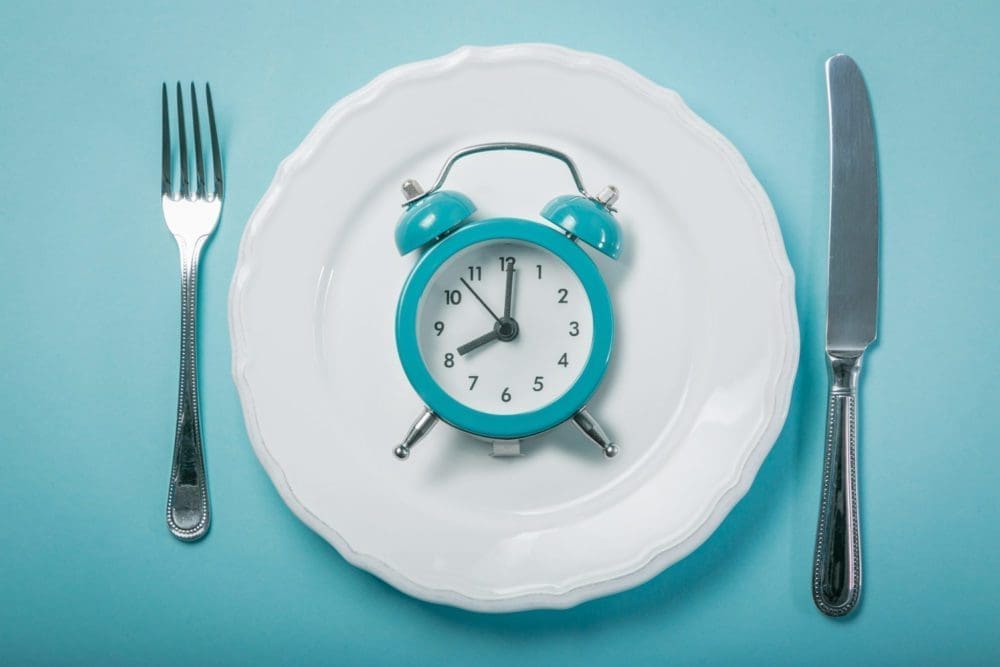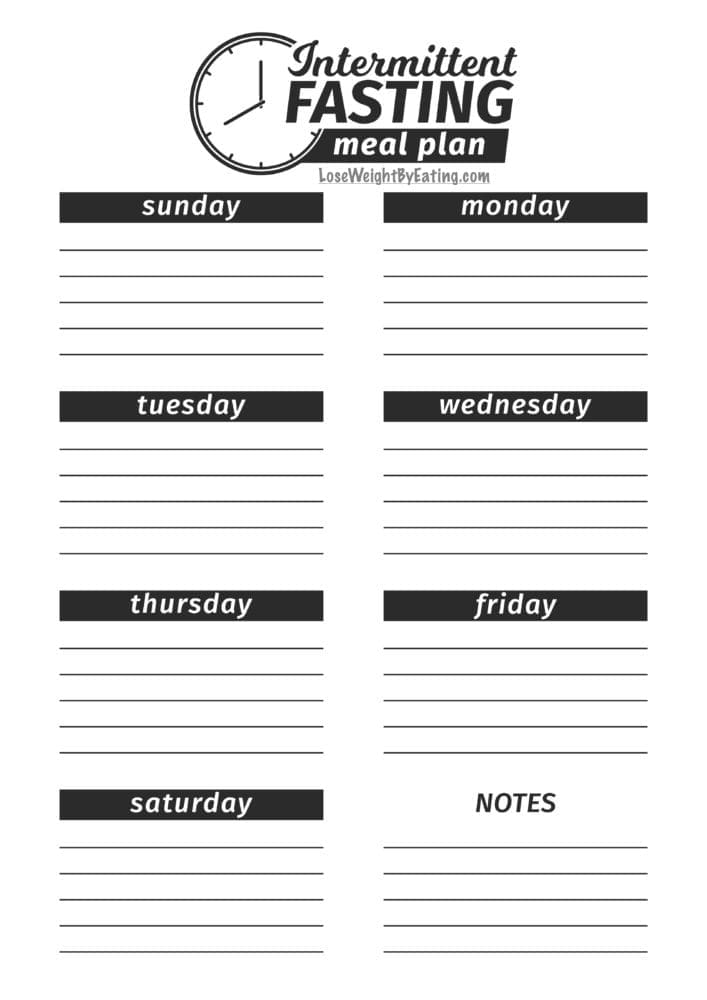Intermittent fasting has gained popularity over the years as a method for weight loss and improving overall health. In this guide, we will explore the science behind intermittent fasting and how it can aid in weight loss.


What is Intermittent Fasting?
Intermittent fasting is a method of eating that involves periods of fasting and feeding. It is not a diet but rather a pattern of eating that focuses on when you eat, rather than what you eat.
Intermittent fasting can be done in different ways, such as the 16/8 method, alternate-day fasting, and the 5:2 method.
How Does Intermittent Fasting Work for Weight Loss?
Intermittent fasting can help with weight loss by reducing calorie intake, increasing metabolism, and improving insulin sensitivity. During the fasting period, the body is forced to use stored fat as a source of energy, resulting in weight loss.
Intermittent fasting can also lead to a reduction in appetite, which can further aid in weight loss.
Benefits of Intermittent Fasting
Intermittent fasting not only aids in weight loss but also has numerous health benefits. These benefits include improving heart health, reducing inflammation, improving brain function, and increasing longevity.
- Promotes weight loss and fat burning
- Improves insulin sensitivity and blood sugar control
- Reduces inflammation in the body
- Enhances brain function and cognition
- Increases energy levels and improves metabolism
- Promotes autophagy, which is the body’s natural process of cellular cleanup and repair
- May lower the risk of chronic diseases such as heart disease and type 2 diabetes
- May help prevent cancer and promote longevity
- Improves gut health and digestive function
- May increase muscle mass and improve body composition
Things to Consider Before Starting Intermittent Fasting
Intermittent fasting is not suitable for everyone. It is essential to consult with a healthcare professional before starting intermittent fasting, especially if you have any medical conditions or are taking medication.
It is also important to choose a fasting method that works best for your lifestyle.
Tips for Successful Intermittent Fasting
Intermittent fasting can be challenging, especially for beginners. Here are some tips to help you succeed:
- Stay hydrated during the fasting period.
- Gradually increase the fasting period to avoid any adverse effects.
- Plan your meals during the feeding period to ensure you are meeting your nutritional needs.
- Choose nutrient-dense foods to maximize the benefits of intermittent fasting.
Choosing Your Intermittent Fasting Plan
There are several types of intermittent fasting plans, and it is essential to choose the one that best suits your lifestyle and health goals. Here are some of the most popular types of intermittent fasting plans:
- The 16/8 method: This method involves an eight-hour feeding window followed by a 16-hour fasting period. For example, you may eat your first meal at noon and your last meal at 8 pm, then fast until noon the next day.
- Alternate-day fasting: This method involves alternating between days of regular eating and days of fasting. For example, you may eat normally on Monday, then fast on Tuesday, eat normally on Wednesday, and so on.
- The 5:2 method: This method involves eating normally for five days a week and restricting calorie intake to 500-600 calories for two non-consecutive days.
- The Eat-Stop-Eat method: This method involves fasting for 24 hours once or twice a week. For example, you may eat your last meal at 6 pm on Monday and then fast until 6 pm on Tuesday.
When choosing your intermittent fasting plan, consider your daily schedule and preferences. For example, if you are not a morning person, the 16/8 method may be better suited for you than alternate-day fasting, which requires a full day of fasting. It is also essential to choose a plan that fits your nutritional needs and goals.
Consult with a healthcare professional before starting any intermittent fasting plan, especially if you have any medical conditions or are taking medication. It is important to ensure that your chosen plan is safe and effective for you.
The 16/8 Method
The 16/8 method, also known as the Leangains method, is one of the most popular types of intermittent fasting plans. It involves fasting for 16 hours and limiting your eating to an eight-hour window. For example, you may eat your first meal at noon and your last meal at 8 pm, then fast until noon the next day.
During the fasting period, you can drink water, coffee, or tea without sugar or milk. It is important to consume a balanced and healthy diet during the feeding window, focusing on whole foods that provide essential nutrients.
The 16/8 method is popular because it is relatively easy to follow and flexible, allowing for a variety of eating schedules. It can also lead to weight loss and improved metabolic health, including lower insulin levels and improved insulin sensitivity.
- The 16/8 method involves fasting for 16 hours and eating within an 8-hour window each day.
- During the 16-hour fast, only water, black coffee, and other non-caloric beverages are allowed.
- The 8-hour eating window can be adjusted to fit individual schedules and preferences.
- This method is easy to implement and can be a good option for beginners.
- It may help with weight loss by reducing calorie intake and improving insulin sensitivity.
- The 16/8 method may also improve blood sugar control and reduce inflammation in the body.
- Some people find that they have increased energy levels and improved digestion while following this method.
- It’s important to ensure that nutrient-dense foods are consumed during the eating window to meet nutritional needs.
- The 16/8 method can be combined with other healthy lifestyle habits, such as regular exercise and adequate sleep, for optimal health benefits.
However, it is important to note that the 16/8 method may not be suitable for everyone. People with certain medical conditions, such as diabetes or low blood sugar, should consult with a healthcare professional before starting this or any other intermittent fasting plan.
Additionally, it is important to ensure that you are consuming enough calories and nutrients during the feeding window to support your health and energy levels. It is recommended to gradually adjust to the 16/8 method, starting with a shorter fasting period and gradually increasing to 16 hours.
The 5:2 Method
The 5:2 method, also known as the Fast Diet, is an intermittent fasting plan that involves eating normally for five days a week and restricting calorie intake to 500-600 calories for two non-consecutive days. For example, you may eat normally on Monday, then restrict your calorie intake on Wednesday and Friday.
During the two fasting days, it is important to consume nutrient-dense foods that provide essential vitamins and minerals while keeping calorie intake low. This may include soups, salads, and vegetables. It is also important to drink plenty of water and avoid high-calorie beverages such as soda and juice.
The 5:2 method has been shown to be an effective way to promote weight loss and improve metabolic health, including lower insulin levels and improved insulin sensitivity. It may also have other health benefits, such as reducing inflammation and improving brain function.
- The 5:2 method involves eating normally for five days a week and restricting calorie intake to 500-600 calories for two non-consecutive days.
- The two fasting days can be adjusted to fit individual schedules and preferences.
- It may help with weight loss by reducing calorie intake and improving insulin sensitivity.
- The 5:2 method may also improve blood sugar control and reduce inflammation in the body.
- Some people find that they have increased energy levels and improved digestion while following this method.
- It’s important to ensure that nutrient-dense foods are consumed on non-fasting days to meet nutritional needs.
- The 5:2 method can be combined with other healthy lifestyle habits, such as regular exercise and adequate sleep, for optimal health benefits.
However, it is important to note that the 5:2 method may not be suitable for everyone. People with certain medical conditions, such as diabetes or low blood sugar, should consult with a healthcare professional before starting this or any other intermittent fasting plan.
It is important to ensure that you are consuming enough calories and nutrients during the non-fasting days to support your health and energy levels. It is recommended to gradually adjust to the 5:2 method, starting with one fasting day per week and gradually increasing to two.
Eat Stop Eat Method
The Eat Stop Eat method involves fasting for 24 hours once or twice a week. During the fasting period, you consume no calories, only water, coffee, or tea without sugar or milk. After the fast, you return to your normal eating habits.
This method can be a challenging form of intermittent fasting, as it involves a longer period of time without food. However, proponents of the Eat Stop Eat method argue that it can lead to improved insulin sensitivity, weight loss, and other health benefits.
- The Eat Stop Eat method involves fasting for 24 hours once or twice a week.
- During the fast, no food is consumed, but calorie-free drinks like water, coffee, and tea are allowed.
- This method may help with weight loss by reducing calorie intake and improving insulin sensitivity.
- Fasting periods may also activate cellular repair processes and increase the production of growth hormone, which can have anti-aging benefits.
- It’s important to ensure that regular meals are consumed on non-fasting days to meet nutritional needs.
- The Eat Stop Eat method can be combined with other healthy lifestyle habits, such as regular exercise and adequate sleep, for optimal health benefits.
It is important to note that the Eat Stop Eat method may not be suitable for everyone. People with certain medical conditions, such as diabetes or low blood sugar, should consult with a healthcare professional before starting this or any other intermittent fasting plan.
It is important to ensure that you are consuming enough calories and nutrients during the feeding window to support your health and energy levels. It is recommended to gradually adjust to the Eat Stop Eat method, starting with a shorter fasting period and gradually increasing to 24 hours.
Alternate-Day Method
The alternate-day fasting method involves alternating between days of unrestricted eating and days of calorie restriction. On fasting days, individuals consume 500-600 calories or no food at all, while on non-fasting days, they eat normally.
This method can be a challenging form of intermittent fasting, as it involves a longer period of time without food every other day. However, proponents of the alternate-day fasting method argue that it can lead to improved insulin sensitivity, weight loss, and other health benefits.
- The alternate-day fasting method involves alternating between a day of fasting (consuming very few calories) and a day of unrestricted eating.
- On fasting days, it’s common to consume around 500-600 calories, usually in the form of low-calorie, nutrient-dense foods.
- This method may help with weight loss by reducing calorie intake and improving insulin sensitivity.
- It may also lead to other health benefits, such as decreased inflammation and improved heart health.
- However, some people may find it difficult to adhere to such a strict eating pattern, and it may not be appropriate for everyone, especially those with underlying health conditions.
- It’s important to ensure that adequate nutrition is consumed on eating days to meet daily nutrient needs.
It is important to note that the alternate-day fasting method may not be suitable for everyone. People with certain medical conditions, such as diabetes or low blood sugar, should consult with a healthcare professional before starting this or any other intermittent fasting plan.
Additionally, it is important to ensure that you are consuming enough calories and nutrients during the feeding window to support your health and energy levels. It is recommended to gradually adjust to the alternate-day fasting method, starting with a shorter fasting period and gradually increasing to a full-day fast.
The Warrior Diet Method
The Warrior diet method involves eating one large meal at night, while consuming small amounts of raw fruits and vegetables during the day. The idea behind this method is to mimic the eating habits of ancient warriors, who would hunt and gather food during the day and feast at night.
During the feeding window, individuals consume a meal that includes lean protein, whole grains, and vegetables. The meal should be nutrient-dense and balanced, providing all of the necessary macronutrients and micronutrients.
This method can be a challenging form of intermittent fasting, as it involves a longer period of time without substantial food. However, proponents of the Warrior diet method argue that it can lead to improved fat loss, increased energy levels, and other health benefits.
- The Warrior Diet method involves eating one large meal at night and fasting during the day.
- During the fasting period, small amounts of fruits, vegetables, and protein are allowed.
- This method may lead to weight loss by reducing calorie intake and increasing satiety.
- It may also lead to improved insulin sensitivity and other health benefits such as decreased inflammation.
- However, some people may find it difficult to consume a large meal at night or may experience digestive discomfort.
- It’s important to ensure that adequate nutrition is consumed during the eating period to meet daily nutrient needs.
It is important to note that the Warrior diet method may not be suitable for everyone. People with certain medical conditions, such as diabetes or low blood sugar, should consult with a healthcare professional before starting this or any other intermittent fasting plan.
Additionally, it is important to ensure that you are consuming enough calories and nutrients during the feeding window to support your health and energy levels. It is recommended to gradually adjust to the Warrior diet method, starting with a shorter feeding window and gradually increasing to a larger meal.
The Warrior diet method can be a safe and effective way to incorporate intermittent fasting into your lifestyle, but it is important to consult with a healthcare professional and listen to your body to ensure that it is right for you.
How Intermittent Fasting Affects Your Hormones
Intermittent fasting can have a significant impact on various hormones in the body, including insulin, human growth hormone (HGH), and cortisol.
Insulin: Intermittent fasting can lead to improved insulin sensitivity, as the body becomes more efficient at using insulin to transport glucose from the bloodstream into cells. This can help to reduce blood sugar levels and improve overall metabolic health.
Human Growth Hormone (HGH): Intermittent fasting can also increase levels of human growth hormone (HGH), which plays an important role in regulating body composition, metabolism, and aging. HGH levels typically increase during fasting periods, which can lead to increased fat burning and muscle growth.
Cortisol: Intermittent fasting can temporarily increase levels of cortisol, a hormone that is often associated with stress. However, this increase in cortisol is typically short-lived and does not have a negative impact on health. In fact, some research suggests that intermittent fasting can actually improve the body’s response to stress over time.
Intermittent fasting can have a significant impact on various hormones in the body, leading to improved insulin sensitivity, increased levels of human growth hormone, and temporary increases in cortisol levels. However, it is important to consult with a healthcare professional before starting any new dietary or lifestyle plan to ensure that it is safe and appropriate for you.
How Intermittent Fasting Helps You Reduce Calories and Lose Weight
Intermittent fasting can be an effective tool for reducing calories and achieving weight loss goals. Here’s how:
- Reduced Calorie Intake: Intermittent fasting restricts the times during which you can eat, which naturally leads to a reduction in calorie intake. By limiting your eating window, you may find it easier to stick to a calorie-controlled diet and avoid snacking or overeating throughout the day.
- Improved Hormone Balance: Intermittent fasting can also help to rebalance hormones involved in hunger and fullness signals. This can lead to a reduced appetite and a greater sense of fullness during meals, making it easier to stick to a calorie-controlled diet and reduce overall calorie intake.
- Increased Fat Burning: During fasting periods, the body may turn to stored fat for energy. This can lead to increased fat burning and weight loss over time, particularly when combined with regular exercise.
- Sustainable and Long-Term: Intermittent fasting can be a sustainable approach to weight loss, as it does not require cutting out entire food groups or following restrictive diets. Instead, it focuses on when you eat, rather than what you eat. This can make it easier to maintain over the long-term and avoid the yo-yo dieting cycle.
Intermittent fasting can be an effective way to reduce calorie intake, improve hormone balance, increase fat burning, and achieve sustainable weight loss.
How Intermittent Fasting May Help You Maintain Muscle Mass When Dieting
One of the concerns with weight loss through dieting is the potential loss of muscle mass. However, intermittent fasting may help to preserve muscle mass while promoting weight loss. Here’s how:
- Increased Growth Hormone: Intermittent fasting may increase the production of growth hormone, which is important for maintaining muscle mass. This can help to counteract the muscle loss that can occur during weight loss.
- Protein Synthesis: During periods of fasting, the body may become more efficient at using amino acids from protein to build and repair muscle tissue. This can help to preserve muscle mass during periods of weight loss.
- Exercise During Feeding Windows: By scheduling exercise during feeding windows, you can ensure that your body has the necessary nutrients to support muscle growth and repair. This can help to preserve muscle mass while promoting weight loss.
- Strategic Feeding: When following an intermittent fasting plan, you can strategically time your meals to ensure that you are consuming adequate protein and nutrients to support muscle mass. This can help to prevent muscle loss during weight loss.
Overall, intermittent fasting may help to preserve muscle mass while promoting weight loss through a combination of increased growth hormone, improved protein synthesis, strategic feeding, and exercise during feeding windows.
How Intermittent Fasting Makes Healthy Eating Simpler
One of the benefits of intermittent fasting is that it can make healthy eating simpler and more sustainable. Here’s how:
- Limited Eating Windows: Intermittent fasting limits the amount of time you have to eat each day, which can help to reduce mindless snacking and encourage more intentional eating. This can help to promote healthier food choices and make it easier to stick to a balanced and nutritious diet.
- Reduced Cravings: By limiting your eating windows, intermittent fasting can also help to reduce cravings for unhealthy foods. This can make it easier to stick to a healthy eating plan and avoid overeating or binge eating.
- Improved Insulin Sensitivity: Intermittent fasting has been shown to improve insulin sensitivity, which can help to regulate blood sugar levels and reduce cravings for sugary or processed foods. This can make it easier to choose healthier options and avoid the negative effects of a high-sugar diet.
- Focus on Nutrient-Dense Foods: When following an intermittent fasting plan, it can be helpful to focus on nutrient-dense foods that provide a wide range of essential vitamins, minerals, and other nutrients. This can help to support overall health and wellbeing while making it easier to maintain a healthy weight.
Overall, intermittent fasting can make healthy eating simpler by limiting eating windows, reducing cravings, improving insulin sensitivity, and encouraging a focus on nutrient-dense foods.
How to Succeed with an Intermittent Fasting Diet
- Choose the Right Method for You: There are several different methods of intermittent fasting, and it is important to choose one that works best for your lifestyle, schedule, and individual needs. Consider factors such as your work schedule, social life, and any health conditions or medications that may affect your ability to fast.
- Set Realistic Goals: When starting an intermittent fasting diet, it is important to set realistic goals that are achievable and sustainable over the long term. This may involve starting with a shorter fasting period and gradually increasing the duration over time, or focusing on achieving other health-related goals such as reducing cravings or improving energy levels.
- Plan Your Meals: Planning your meals in advance can help to ensure that you are consuming a balanced and nutritious diet that provides all the essential nutrients your body needs. This can also help to reduce the temptation to overeat or make unhealthy food choices during your eating windows.
- Stay Hydrated: Staying hydrated is important for overall health and wellbeing, and it can also help to reduce hunger and cravings during fasting periods. Make sure to drink plenty of water, herbal tea, or other non-caloric beverages throughout the day to stay hydrated.
- Stay Flexible: Intermittent fasting can be a flexible and adaptable approach to dieting, and it is important to stay flexible and make adjustments as needed based on your individual needs and preferences. This may involve modifying your fasting windows, adjusting your eating habits or meal plans, or incorporating other lifestyle changes such as exercise or stress management techniques.
- Consult with a Healthcare Professional: As with any new diet or lifestyle plan, it is important to consult with a healthcare professional before starting an intermittent fasting diet. They can help to ensure that the plan is safe and appropriate for you, and provide guidance on how to maximize the benefits of intermittent fasting while minimizing any potential risks.
By following these tips and strategies, you can set yourself up for success with an intermittent fasting diet and enjoy the many health benefits that it has to offer.
Frequently Asked Questions (FAQ)
Intermittent fasting is a dietary approach that involves alternating periods of fasting with periods of eating. There are several different methods of intermittent fasting, but all involve restricting calorie intake during certain periods of time.
For most healthy adults, intermittent fasting is generally considered safe. However, it is important to consult with a healthcare professional before starting an intermittent fasting diet, especially if you have any underlying health conditions or are taking any medications.
Intermittent fasting has been shown to have several potential health benefits, including weight loss, improved insulin sensitivity, reduced inflammation, and improved brain function.
Yes, it is generally recommended to drink plenty of water and other non-caloric beverages such as herbal tea or black coffee during fasting periods to stay hydrated.
Yes, it is generally safe to exercise while intermittent fasting. However, it is important to listen to your body and adjust your exercise routine as needed based on your energy levels and individual needs.
Yes, intermittent fasting does not necessarily require you to give up your favorite foods or follow a strict diet plan. However, it is important to maintain a balanced and nutritious diet during eating periods to ensure that your body is getting all the essential nutrients it needs.
Intermittent fasting may not be suitable or effective for everyone, and it is important to consult with a healthcare professional before starting an intermittent fasting diet. Additionally, results may vary depending on individual factors such as age, gender, and overall health status.
There are several different methods of intermittent fasting, and it is important to choose one that works best for your lifestyle, schedule, and individual needs. Consider factors such as your work schedule, social life, and any health conditions or medications that may affect your ability to fast.


Try these 3 Easy Intermittent Fasting Schedules:


3 Best Intermittent Fasting Schedules for Weight Loss
Instructions
The Intermittent Fasting 16/8 plan:
- Eat 3 healthy meals in the span of 8 hours (example: start at 7:00am and end at 3:00pm).
- Fast for 16 hours.
- Be sure to drink lots of water!
- This Intermittent Fasting 16/8 plan involves restricting your eating hours to only 8 hours per day. Fasting for the remaining 16 hours. Many people find skipping breakfast helps limit the hours of eating, they choose to eat from 11am-7pm. Others skip dinner and eat from 7am to 3pm.
- SPECIAL TIP: If the 16 hours of fasting is too difficult, start with an 12/12 fast… eat healthy for 12 hours and fast for 12. You can gradually move to the 16/8 plan from there adding one extra hour of fasting per day.
The Intermittent Fasting Plan Eat Stop Eat:
- Fast for 24 hours.
- Break your fast with a healthy meal consisting of fats (this tells your body to burn more fat).
- East for 2 days, then fast for another 24 hours.
- Be sure to drink lots of water!
- Perhaps the simplest Intermittent Fasting plan. The Eat Stop Eat plan involves fasting for 24 hours 1-2 days a week. Most people eat only one meal on the fasting days, and they most often choose dinner as that single meal.
- SPECIAL TIP: If you start to feel lightheaded, have a cup of hot chicken (or vegetable) broth with a little salt in it. It will help regulate your body.
The Intermittent Fasting Plan 5/2:
- Two days a week limit your calories to 500 calories.
- Make sure to have a regular day of eating in-between the fasting days to recover.
- Be sure to drink lots of water!
- This Intermittent Fasting plan limits only two days of your week. On the two chosen days, one will limit their food to 500 calories.
- SPECIAL TIP: If you start to feel lightheaded, have a cup of hot chicken (or vegetable) broth with a little salt in it. It will help regulate your body.
Final Thoughts on Intermittent Fasting
Intermittent fasting is a promising dietary approach that has been shown to have numerous health benefits, including weight loss, improved blood sugar control, and reduced inflammation. With several different methods to choose from, it is possible to find an intermittent fasting plan that works for your lifestyle and goals.
Remember, it’s important to consult with a healthcare professional before starting any new diet or exercise program, especially if you have underlying health conditions. Intermittent fasting may not be suitable for everyone, and it’s crucial to ensure that you’re meeting your nutritional needs during your eating periods.
With dedication, patience, and a willingness to experiment with different fasting methods, you can successfully incorporate intermittent fasting into your lifestyle and reap the benefits it has to offer.
What To Read Next:






Pin this Article to Pinterest:


Article History:
- Originally written and published on November 10, 2019 by Audrey Johns
- Updated on November 22, 2020 by Audrey Johns
- Updated on March 20, 2023 by Audrey Johns

Pingback: How to Lose Weight Fast | 10 Weight Loss Tips - Lose Weight By Eating
Pingback: The Best Snacks for Weight Loss
Pingback: 1200 Calorie Meal Plan for Fast Weight Loss by Audrey Johns